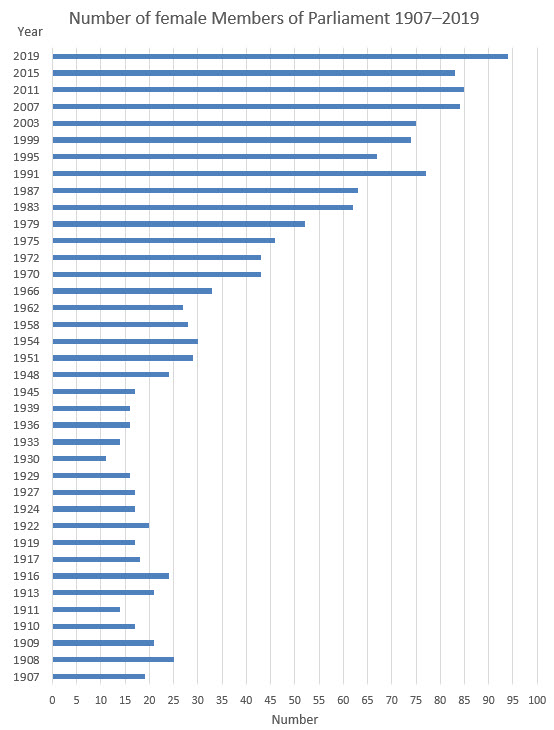The Parliament's number of women has ballooned in a little over a century
In 1907, the number of women elected was 19, with women's share of Members of Parliament at 9.5 %. The share of women is the highest ever in the parliament that began its term in 2019, with 94 women MPs (47 % of all MPs). The number of women in the Parliament has increased to such a significant degree in one hundred years that the gender ratio is now balanced, even though women have yet to achieve a majority.
In the pre-independence era, the number of women was higher than in 1907 on a couple of occasions (1908: 24; 1916: 25). The Parliament that started its work in 1916 had one in eight female Members of Parliament; remarkable at a time when women were usually simply not elected to the Parliament.
Gaining independence turned the number of female representatives downwards: between the two world wars, the number of female Members of Parliament reached ten per cent only once (1922: 20). The trough was hit in the 1930 election, when only 11 women (5.5 %) were elected. The contributing factors for this are sought for in the values of the time and the society's conception of motherhood: woman's work was done at home, in the family circle, not with representational democracy at the Parliament.
The number of women at the Parliament began to grow in the elections succeeding the WWII. The growth in the number of women has taken place at a particularly rapid pace as of the late 1960s, preceded by a slight fall in the late 1950s. Women's number in the Parliament exceeded the 20 per cent limit in the 1970 election and 30 per cent in the 1983 election. In the 1991 election, a superb record was set as 77 female Members of Parliament were elected. With 67 elected female Members of Parliament, the 1995 election saw, for the first time in over thirty years, a decrease in the number of women elected. In the 2007 election, the 40 per cent limit was broken.
Number of female Members of Parliament, 1907–2019

Figure 3. Number of female Members of Parliament, 1907–2019
Detailed number data in
the Appendix
The development of female representation in the Parliament can be examined with the help of the model below:
-
Male domination Under 10 per cent of the elected candidates are women.
-
Women as a small minority 10–25 per cent of the elected candidates are women.
-
Women as a large minority 25–40 per cent of the elected candidates are women.
-
Gender equality 40–60 per cent of the elected candidates are women (Dahlerup – Layenaar 2013, 8–10).
Based on a review of this kind, there has been male domination at the Parliament before the 1948 election apart from a few occasions. Women have been a large minority from 1979. Gender balance has prevailed at the Parliament from 2007 on.